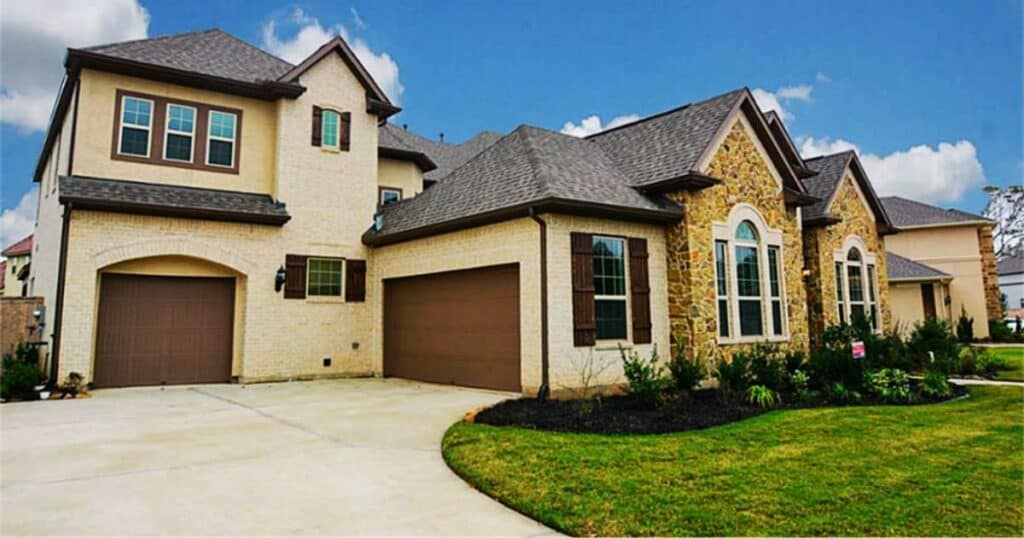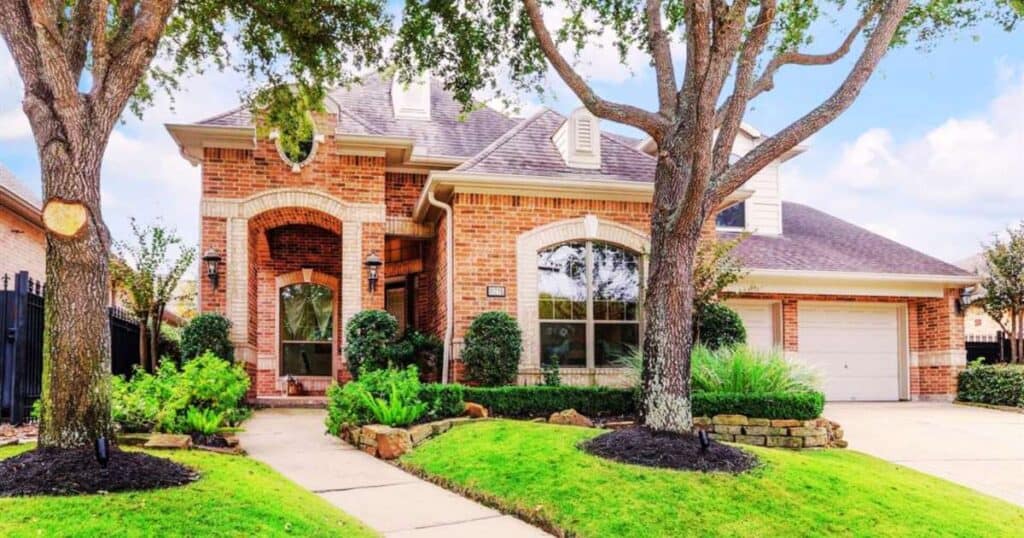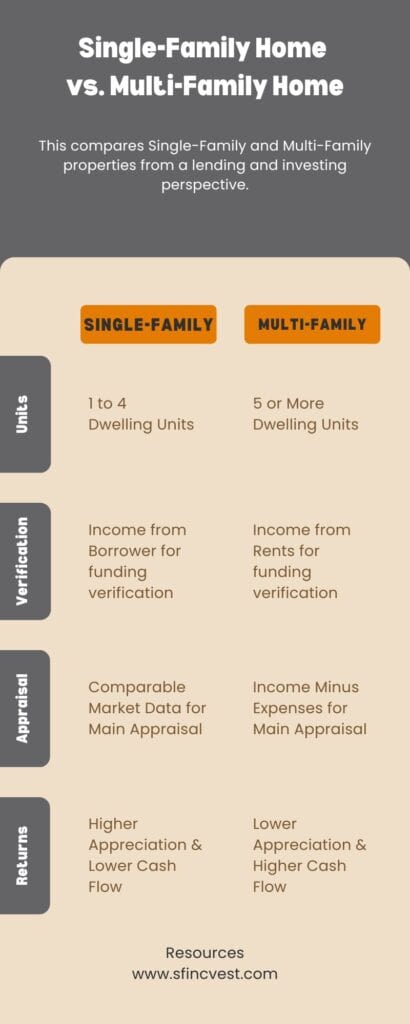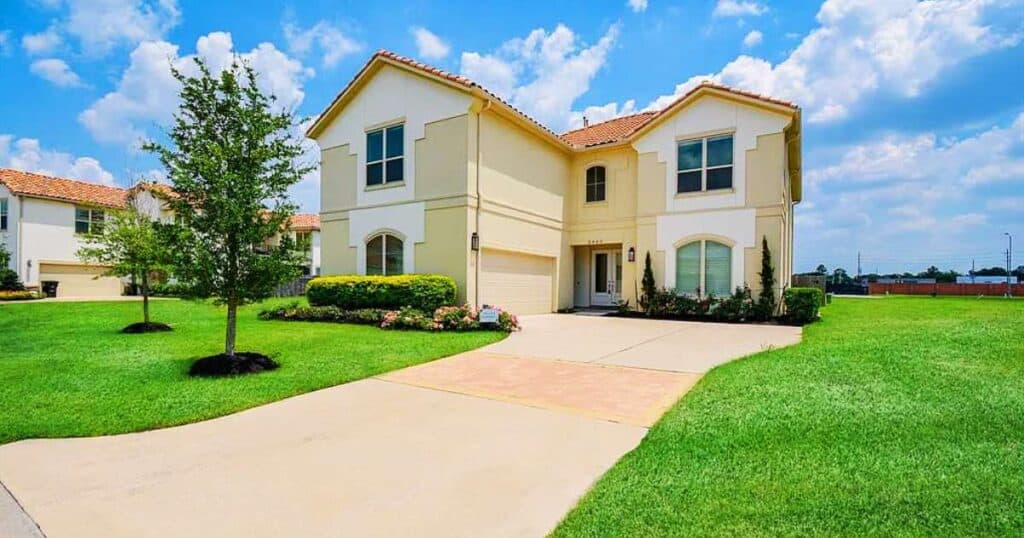Having invested in real estate, particularly multiple single-family homes, I can understand the confusion in real estate terminology that leads to questions like “What is a Single-Family Home?”.
In general, a single-family home is a standalone residential building intended for one household unit with its own land and direct access, while multifamily homes have multiple units. Regarding lending and government reporting, single-family properties include one to four residence units.
In this article, I will take you through a quick deep dive into single-family homes while sharing what I have researched from the U.S. Census Bureau and what I learned the hard way as a single-family homeowner and investor.
We will cover:
General Information Only
We are committed to providing accurate information to the best of our knowledge. The information provided in this article is intended for general informational purposes only. It is not a substitute for professional advice and should not be relied upon as such. See our terms of service here.

What is a Single-Family Home?
The definition and meaning of a single-family home can vary depending on the context.
Generally, a single-family home is a standalone residential structure built to house one family or household. It doesn’t share walls or utilities with another residence and usually has its own separate lot.
Single-family can be defined in other contexts as follows:
Government Statistics
The U.S. Census Bureau collects data on American housing, including stock, costs, and ownership, through surveys like the Decennial Census and the American Community Survey. The Census Bureau says:
“Single-family structures include fully detached, semi-detached (semi-attached, side-by-side), row houses, duplexes, quadruplexes, and townhouses. In order for attached units to be classified as single-family structures, each unit must: be separated by a ground-to-roof wall, have a separate heating system, have individual meters for public utilities, and have no units located above or below.”
The U.S. Census Bureau
Mortgage and Lending
The U.S. Federal Housing Administration (FHA) plays a prominent role in American housing finance, and it states:
“Single Family refers to one- to four-unit dwellings,” whereas “dwelling unit refers to a single unit of residence for a household of one or more persons.”
The FHA Single Family Housing Policy Handbook
Features of Single-Family Homes
Single-family home key features often include:
- Ground-to-Roof Wall: Extends from the ground up, without shared floors.
- No Vertical Neighbors: Absence of neighboring units above or below.
- Separate Heating: Dedicated and independent heating system.
- Separate Metering: Individual metering for public utilities.
- Exclusive Yard: A private outdoor gardening, relaxation, or play space.
- Direct Access: No shared hallways or communal entryways.
- Private Parking: A dedicated garage or parking spot.
- Enhanced Privacy: More separation leads to increased privacy.
Now we’ve covered the basics, let’s dig further for more understanding of what is a single-family home.
In the subsequent sections, we’ll cover the differences between the types of single-family homes and the pros and cons of single-family housing.

Single-Family Types: Attached vs. Detached
In my journey with single-family homes, I often needed clarification on the classification of single-family housing as attached, semi-detached, or detached in line with the U.S. Census Bureau statistics.
Single-family housing can be categorized based on attachment: Detached homes standalone, Semi-detached share one common wall with another unit, and Attached homes, like townhouses, share walls on both sides. Each offers varying levels of privacy and space.
Let’s look at each in more detail.
What is a Single-Family Attached Home?
A single-family attached home is a home for one household unit that shares more than one wall with adjacent units (side-by-side), often seen in townhouses or row houses. Unlike multifamily units or apartment buildings, each unit has direct access from the outside and private entrances.
What is a Single-Family Semi-Detached Home?
A single-family semi-detached home comprises two separate residence units connected by a common wall, like duplexes. Each side operates as an individual unit with its own yard and private entrances. Attached homes share multiple walls, while semi-detached houses share only one wall.
What is a Single-Family Detached Home?
A single-family detached home is a standalone residential structure for one household built on its land. Unlike attached or semi-detached houses, it doesn’t share walls with neighbors. It is commonly considered the traditional single-family residence, offering more privacy and separate ownership.
Now, let’s cover in the subsequent sections how single-family homes compare with other residential properties like multifamily, condominiums, mobile homes, apartments, and others.
Single-Family Homes vs. Multifamily Homes
A regular comparison in real estate is the difference between single-family and multifamily housing.
In real estate listings, a single-family home is a standalone building for one household unit with its own land, while multifamily homes have multiple units. In lending and government statistics, multifamily refers to residential properties with five or more units.
From a lending perspective, a summary of key differences between Single-Family and Multifamily Homes are summarized in the clip below.

Let’s now see single-family comparisons to other residential home types in the next section to give you a complete understanding.
Other Single-Family Comparisons
The single-family home term is typically compared with other residential home terms as follows:
Single-Family Homes vs. Duplexes
Generally, single-family homes are standalone residential structures for one household, while duplexes have two separate residence units with a common wall. In U.S. government statistics, duplexes, triplexes, and quadplexes are single-family structures.
Single-Family Homes vs. Condominiums
While single-family homes provide land ownership and separation, condominiums, also known as condos, are residential units within a larger building where owners privately own their unit’s interior but share ownership of common areas and amenities.
Single-Family Homes vs. Townhouses
According to the U.S. Census Bureau, a townhouse is a single-family structure. A townhouse is attached to similar homes in a row, sharing one or more walls, each with direct access. Owners own the interior and, in most cases, a small plot of land or yard.
Single-Family Homes vs. Mobile Homes
A mobile home (manufactured home) is a prefabricated residence built off-site on a chassis, allowing for easy relocation. Still, it is often placed in one location and used as a permanent dwelling. Unlike the fixed foundation of single-family homes, mobile homes often sit on leased land.
Single-Family Homes vs. Apartments
A single-family home is a standalone dwelling on its land, typically offering privacy and ownership of the structure and land. An apartment is a residence unit within a larger building, often rented, with shared amenities and less individual outdoor space.
Now you understand how single-family homes are defined and compared, I’ll explain their advantages and disadvantages in the next section to fully update you.
Pros and Cons of Single-Family Homes
Understanding the benefits and drawbacks of your decision-making on single-family homes against other home options is quite helpful.
Here, I’ll share the advantages and disadvantages of single-family housing.
Advantages of Single-Family Homes
- Better Privacy: A single-family detached home offers more privacy than a multifamily.
- Direct Access: Private individual entrances distinct from apartment complexes.
- Own Yard: A dedicated yard or garden space is a crucial selling point.
- More Space: Typically larger space to store your belongings and other activities.
- Less Noise: There is less disturbance with no vertical neighbors or shared floors.
- Value Appreciation: A historically steady average trend of increased home value.
- Easier Customization: Easier home modifications compared to multifamily units.
Disadvantages of Single-Family Homes
- Higher Maintenance: Individual maintenance costs, unlike shared costs in multifamily.
- Higher Taxes: Property taxes can be higher compared to multifamily units.
- More Investment: Tend to have higher initial investments and down payments.
- Higher Insurance: Often higher insurance costs than multifamily residences.
- More Isolation: Sometimes, one could have less of a community feel.
With the details you have now on your journey with single-family homes, I’ll share some considerations before buying.

Before You Buy a Single-Family Home
Having purchased and currently owning multiple single-family homes, some points to consider before a home purchase include:
Renting vs. Owning
Renting offers flexibility, while owning a single-family house can build equity over time. However, ownership ties you to a location and comes with long-term financial commitments, unlike the short-term nature of renting a home.
Cost Implications
Beyond the purchase price of a single-family home, consider property taxes, insurance, and maintenance costs that could be significant. Then, factor in the down payment and the impact of mortgage expenses on your personal finances to ensure sustainable affordability over time.
Location and Lifestyle Fit
The location of your home influences commute, amenities, and lifestyle. Evaluate the fit of the location and neighborhood with your long-term plans, the proximity to preferred schools, and access to recreational areas.
Maintenance Responsibilities
When you own a single-family detached house, general maintenance is your responsibility. No landlord or property manager as in multifamily homes or apartment buildings. From air conditioning systems to yard care, the upkeep is on the homeowner.
Considering all these points and you buy a single-family home, consider the top risk management tools in owning and living in single-family homes.
Next, we answer frequently asked questions about ‘what is a single-family home?’.
FAQs: What is a Single Family Home?
Conclusion
Understanding the concept of “what is a single-family home?” is essential for anyone venturing into real estate.
A single-family home is a unique choice, offering privacy, ownership, and a sense of belonging.
Some key takeaways:
- A single-family home is a standalone structure meant for one household.
- Homes can be detached, semi-detached, or attached, each with distinct features.
- Unlike multifamily, single-family homes usually offer more privacy and land ownership.
- Single-family homes have different investment potentials compared to other properties.
Here are some actionable tips before you buy a home:
- Research: Understand the local market before purchasing.
- Seek Expertise: Engage with professionals for insights.
- Assess Needs: Match the house with your long-term goals.
- Stay Informed: Real estate trends evolve; stay updated.
Equipped with this knowledge, you are more informed to make decisions in your real estate journey.
Join Our Community
Embark on your real estate journey with a supportive community by your side:
- Get our Passive Income Checklist, which is a free guide.
- Join our Newsletter to stay updated with our latest insights.
- Read our Blog to immerse yourself in rich real estate content.
- Connect with us on Facebook, Twitter, and Instagram to engage.
References
- U.S. Census Bureau (2022), “Definitions – Survey of Construction,” [Link].
- U.S. Federal Housing Administration (2022), “FHA Single Family Housing Policy Handbook,” [Link].
- U.S. Census Bureau (2021), “Data Tables: Physical Housing Characteristics.” [Link].
- FreddieMac (2023), “The Difference Between Multifamily and Single-Family Businesses” [Link].
- National Fire Protection Association (2021), “Occupancy Classifications in Codes,” [Link].

